Special Issue of IPSERA Conference 2016: Purchasing & Supply Management in an Integrated Supply Chain
VerifiedAdded on 2023/02/01
|14
|6119
|44
AI Summary
This special issue explores the theme of Purchasing & Supply Management: From efficiency to effectiveness in an integrated supply chain, discussed at the 25th annual IPSERA conference in 2016. The articles in this issue examine the impact of PSM on supply chain effectiveness and integration, and propose a framework for further research in this area. Topics covered include supply chain transparency, sustainability, product quality, innovation, and more.
Contribute Materials
Your contribution can guide someone’s learning journey. Share your
documents today.
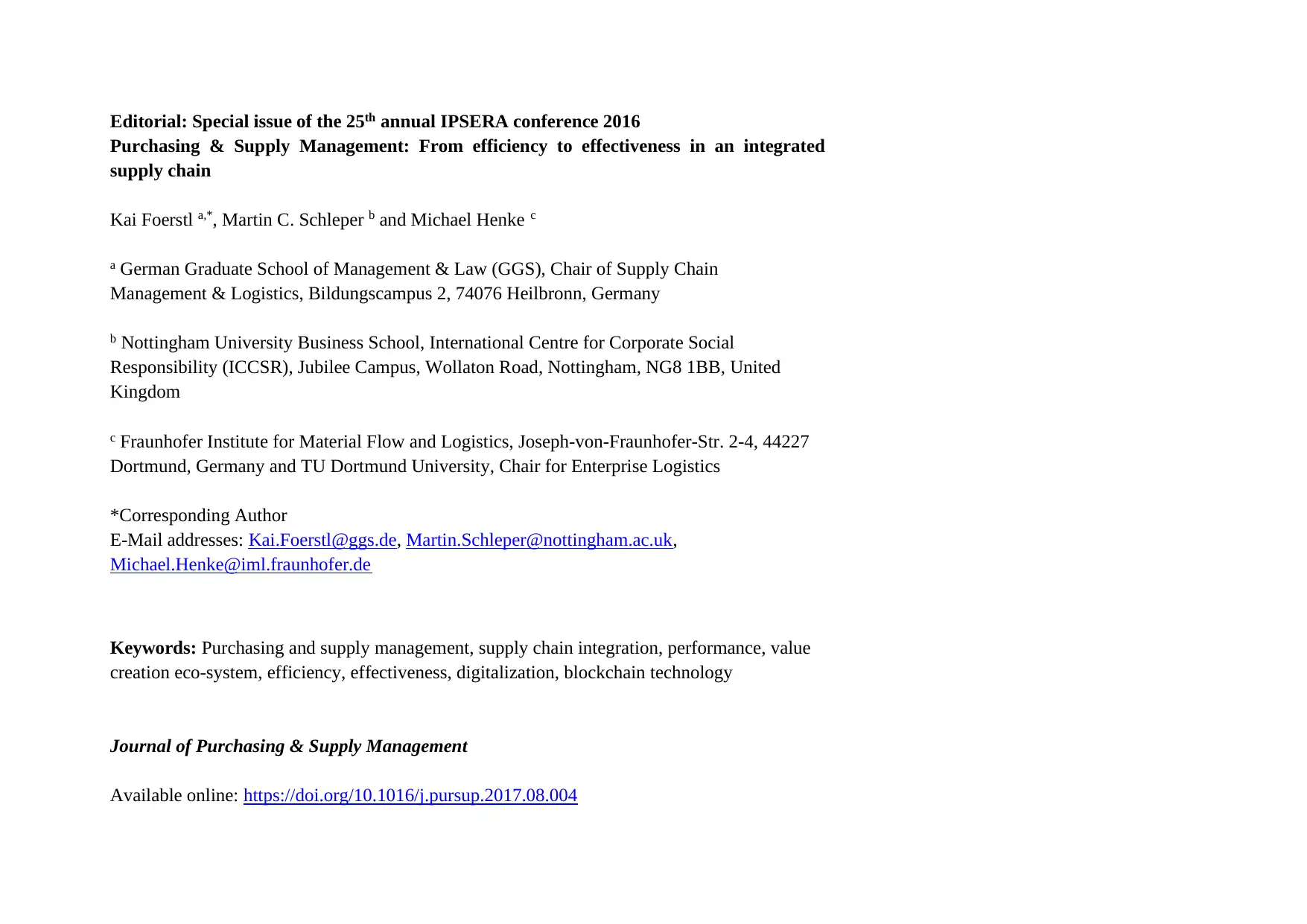
Editorial: Special issue of the 25th annual IPSERA conference 2016
Purchasing & Supply Management: From efficiency to effectiveness in an integrated
supply chain
Kai Foerstl a,*, Martin C. Schleper b and Michael Henke c
a German Graduate School of Management & Law (GGS), Chair of Supply Chain
Management & Logistics, Bildungscampus 2, 74076 Heilbronn, Germany
b Nottingham University Business School, International Centre for Corporate Social
Responsibility (ICCSR), Jubilee Campus, Wollaton Road, Nottingham, NG8 1BB, United
Kingdom
c Fraunhofer Institute for Material Flow and Logistics, Joseph-von-Fraunhofer-Str. 2-4, 44227
Dortmund, Germany and TU Dortmund University, Chair for Enterprise Logistics
*Corresponding Author
E-Mail addresses: Kai.Foerstl@ggs.de, Martin.Schleper@nottingham.ac.uk,
Michael.Henke@iml.fraunhofer.de
Keywords: Purchasing and supply management, supply chain integration, performance, value
creation eco-system, efficiency, effectiveness, digitalization, blockchain technology
Journal of Purchasing & Supply Management
Available online: https://doi.org/10.1016/j.pursup.2017.08.004
Purchasing & Supply Management: From efficiency to effectiveness in an integrated
supply chain
Kai Foerstl a,*, Martin C. Schleper b and Michael Henke c
a German Graduate School of Management & Law (GGS), Chair of Supply Chain
Management & Logistics, Bildungscampus 2, 74076 Heilbronn, Germany
b Nottingham University Business School, International Centre for Corporate Social
Responsibility (ICCSR), Jubilee Campus, Wollaton Road, Nottingham, NG8 1BB, United
Kingdom
c Fraunhofer Institute for Material Flow and Logistics, Joseph-von-Fraunhofer-Str. 2-4, 44227
Dortmund, Germany and TU Dortmund University, Chair for Enterprise Logistics
*Corresponding Author
E-Mail addresses: Kai.Foerstl@ggs.de, Martin.Schleper@nottingham.ac.uk,
Michael.Henke@iml.fraunhofer.de
Keywords: Purchasing and supply management, supply chain integration, performance, value
creation eco-system, efficiency, effectiveness, digitalization, blockchain technology
Journal of Purchasing & Supply Management
Available online: https://doi.org/10.1016/j.pursup.2017.08.004
Secure Best Marks with AI Grader
Need help grading? Try our AI Grader for instant feedback on your assignments.
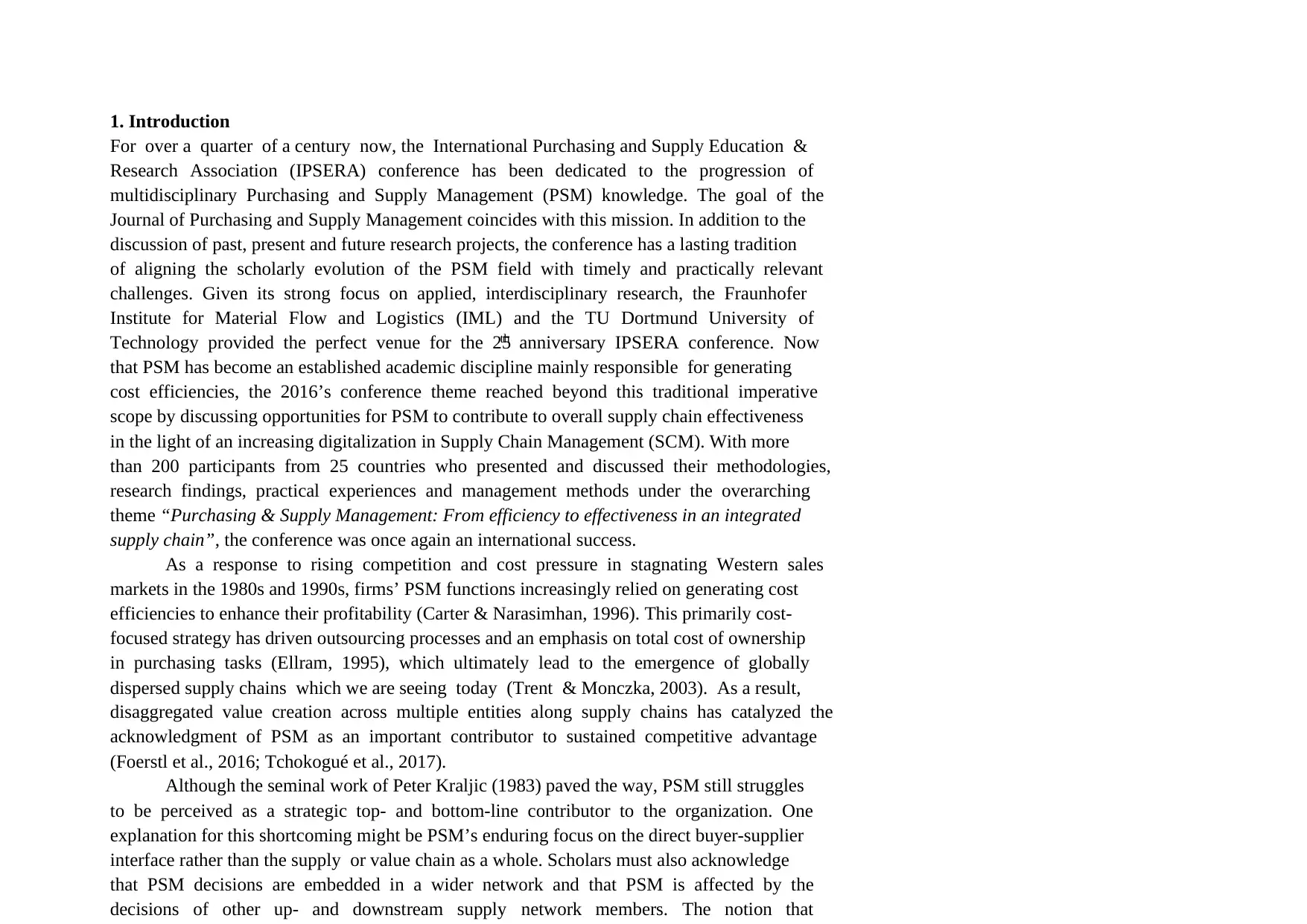
1. Introduction
For over a quarter of a century now, the International Purchasing and Supply Education &
Research Association (IPSERA) conference has been dedicated to the progression of
multidisciplinary Purchasing and Supply Management (PSM) knowledge. The goal of the
Journal of Purchasing and Supply Management coincides with this mission. In addition to the
discussion of past, present and future research projects, the conference has a lasting tradition
of aligning the scholarly evolution of the PSM field with timely and practically relevant
challenges. Given its strong focus on applied, interdisciplinary research, the Fraunhofer
Institute for Material Flow and Logistics (IML) and the TU Dortmund University of
Technology provided the perfect venue for the 25th anniversary IPSERA conference. Now
that PSM has become an established academic discipline mainly responsible for generating
cost efficiencies, the 2016’s conference theme reached beyond this traditional imperative
scope by discussing opportunities for PSM to contribute to overall supply chain effectiveness
in the light of an increasing digitalization in Supply Chain Management (SCM). With more
than 200 participants from 25 countries who presented and discussed their methodologies,
research findings, practical experiences and management methods under the overarching
theme “Purchasing & Supply Management: From efficiency to effectiveness in an integrated
supply chain”, the conference was once again an international success.
As a response to rising competition and cost pressure in stagnating Western sales
markets in the 1980s and 1990s, firms’ PSM functions increasingly relied on generating cost
efficiencies to enhance their profitability (Carter & Narasimhan, 1996). This primarily cost-
focused strategy has driven outsourcing processes and an emphasis on total cost of ownership
in purchasing tasks (Ellram, 1995), which ultimately lead to the emergence of globally
dispersed supply chains which we are seeing today (Trent & Monczka, 2003). As a result,
disaggregated value creation across multiple entities along supply chains has catalyzed the
acknowledgment of PSM as an important contributor to sustained competitive advantage
(Foerstl et al., 2016; Tchokogué et al., 2017).
Although the seminal work of Peter Kraljic (1983) paved the way, PSM still struggles
to be perceived as a strategic top- and bottom-line contributor to the organization. One
explanation for this shortcoming might be PSM’s enduring focus on the direct buyer-supplier
interface rather than the supply or value chain as a whole. Scholars must also acknowledge
that PSM decisions are embedded in a wider network and that PSM is affected by the
decisions of other up- and downstream supply network members. The notion that
For over a quarter of a century now, the International Purchasing and Supply Education &
Research Association (IPSERA) conference has been dedicated to the progression of
multidisciplinary Purchasing and Supply Management (PSM) knowledge. The goal of the
Journal of Purchasing and Supply Management coincides with this mission. In addition to the
discussion of past, present and future research projects, the conference has a lasting tradition
of aligning the scholarly evolution of the PSM field with timely and practically relevant
challenges. Given its strong focus on applied, interdisciplinary research, the Fraunhofer
Institute for Material Flow and Logistics (IML) and the TU Dortmund University of
Technology provided the perfect venue for the 25th anniversary IPSERA conference. Now
that PSM has become an established academic discipline mainly responsible for generating
cost efficiencies, the 2016’s conference theme reached beyond this traditional imperative
scope by discussing opportunities for PSM to contribute to overall supply chain effectiveness
in the light of an increasing digitalization in Supply Chain Management (SCM). With more
than 200 participants from 25 countries who presented and discussed their methodologies,
research findings, practical experiences and management methods under the overarching
theme “Purchasing & Supply Management: From efficiency to effectiveness in an integrated
supply chain”, the conference was once again an international success.
As a response to rising competition and cost pressure in stagnating Western sales
markets in the 1980s and 1990s, firms’ PSM functions increasingly relied on generating cost
efficiencies to enhance their profitability (Carter & Narasimhan, 1996). This primarily cost-
focused strategy has driven outsourcing processes and an emphasis on total cost of ownership
in purchasing tasks (Ellram, 1995), which ultimately lead to the emergence of globally
dispersed supply chains which we are seeing today (Trent & Monczka, 2003). As a result,
disaggregated value creation across multiple entities along supply chains has catalyzed the
acknowledgment of PSM as an important contributor to sustained competitive advantage
(Foerstl et al., 2016; Tchokogué et al., 2017).
Although the seminal work of Peter Kraljic (1983) paved the way, PSM still struggles
to be perceived as a strategic top- and bottom-line contributor to the organization. One
explanation for this shortcoming might be PSM’s enduring focus on the direct buyer-supplier
interface rather than the supply or value chain as a whole. Scholars must also acknowledge
that PSM decisions are embedded in a wider network and that PSM is affected by the
decisions of other up- and downstream supply network members. The notion that
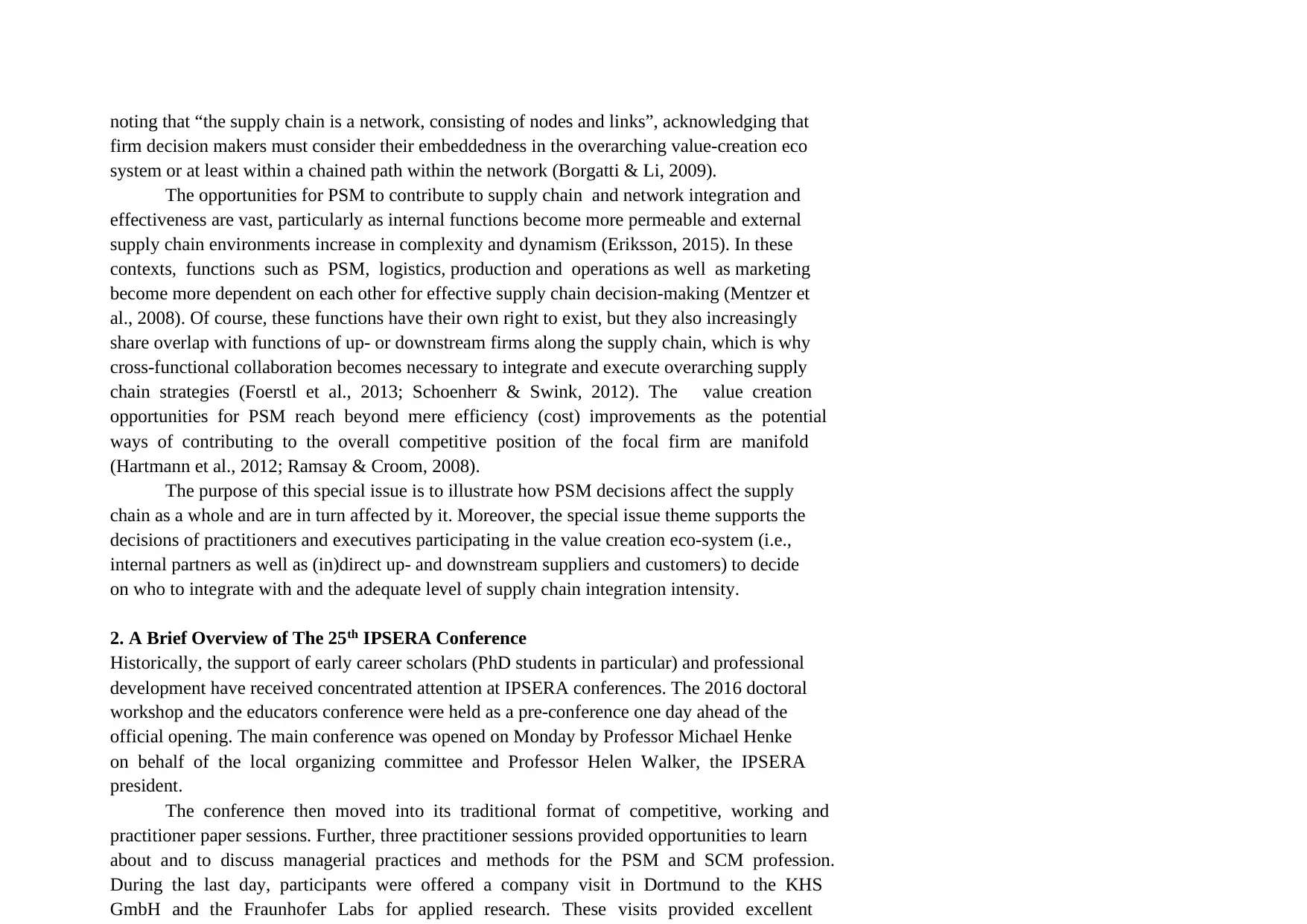
noting that “the supply chain is a network, consisting of nodes and links”, acknowledging that
firm decision makers must consider their embeddedness in the overarching value-creation eco
system or at least within a chained path within the network (Borgatti & Li, 2009).
The opportunities for PSM to contribute to supply chain and network integration and
effectiveness are vast, particularly as internal functions become more permeable and external
supply chain environments increase in complexity and dynamism (Eriksson, 2015). In these
contexts, functions such as PSM, logistics, production and operations as well as marketing
become more dependent on each other for effective supply chain decision-making (Mentzer et
al., 2008). Of course, these functions have their own right to exist, but they also increasingly
share overlap with functions of up- or downstream firms along the supply chain, which is why
cross-functional collaboration becomes necessary to integrate and execute overarching supply
chain strategies (Foerstl et al., 2013; Schoenherr & Swink, 2012). The value creation
opportunities for PSM reach beyond mere efficiency (cost) improvements as the potential
ways of contributing to the overall competitive position of the focal firm are manifold
(Hartmann et al., 2012; Ramsay & Croom, 2008).
The purpose of this special issue is to illustrate how PSM decisions affect the supply
chain as a whole and are in turn affected by it. Moreover, the special issue theme supports the
decisions of practitioners and executives participating in the value creation eco-system (i.e.,
internal partners as well as (in)direct up- and downstream suppliers and customers) to decide
on who to integrate with and the adequate level of supply chain integration intensity.
2. A Brief Overview of The 25th IPSERA Conference
Historically, the support of early career scholars (PhD students in particular) and professional
development have received concentrated attention at IPSERA conferences. The 2016 doctoral
workshop and the educators conference were held as a pre-conference one day ahead of the
official opening. The main conference was opened on Monday by Professor Michael Henke
on behalf of the local organizing committee and Professor Helen Walker, the IPSERA
president.
The conference then moved into its traditional format of competitive, working and
practitioner paper sessions. Further, three practitioner sessions provided opportunities to learn
about and to discuss managerial practices and methods for the PSM and SCM profession.
During the last day, participants were offered a company visit in Dortmund to the KHS
GmbH and the Fraunhofer Labs for applied research. These visits provided excellent
firm decision makers must consider their embeddedness in the overarching value-creation eco
system or at least within a chained path within the network (Borgatti & Li, 2009).
The opportunities for PSM to contribute to supply chain and network integration and
effectiveness are vast, particularly as internal functions become more permeable and external
supply chain environments increase in complexity and dynamism (Eriksson, 2015). In these
contexts, functions such as PSM, logistics, production and operations as well as marketing
become more dependent on each other for effective supply chain decision-making (Mentzer et
al., 2008). Of course, these functions have their own right to exist, but they also increasingly
share overlap with functions of up- or downstream firms along the supply chain, which is why
cross-functional collaboration becomes necessary to integrate and execute overarching supply
chain strategies (Foerstl et al., 2013; Schoenherr & Swink, 2012). The value creation
opportunities for PSM reach beyond mere efficiency (cost) improvements as the potential
ways of contributing to the overall competitive position of the focal firm are manifold
(Hartmann et al., 2012; Ramsay & Croom, 2008).
The purpose of this special issue is to illustrate how PSM decisions affect the supply
chain as a whole and are in turn affected by it. Moreover, the special issue theme supports the
decisions of practitioners and executives participating in the value creation eco-system (i.e.,
internal partners as well as (in)direct up- and downstream suppliers and customers) to decide
on who to integrate with and the adequate level of supply chain integration intensity.
2. A Brief Overview of The 25th IPSERA Conference
Historically, the support of early career scholars (PhD students in particular) and professional
development have received concentrated attention at IPSERA conferences. The 2016 doctoral
workshop and the educators conference were held as a pre-conference one day ahead of the
official opening. The main conference was opened on Monday by Professor Michael Henke
on behalf of the local organizing committee and Professor Helen Walker, the IPSERA
president.
The conference then moved into its traditional format of competitive, working and
practitioner paper sessions. Further, three practitioner sessions provided opportunities to learn
about and to discuss managerial practices and methods for the PSM and SCM profession.
During the last day, participants were offered a company visit in Dortmund to the KHS
GmbH and the Fraunhofer Labs for applied research. These visits provided excellent

during the breaks and particularly at the evening events. A visit to the Westphalia Stadium in
Dortmund (Signal IDUNA Park) concluded the first day of the main conference. In the course
of this night, Dr. Barbara Katharina Yilmaz (né e Wichmann) from WHU – Otto Beisheim
School of Management, Vallendar, was honoured with the first IPSERA Best Doctoral
Dissertation Award 2015 for her thesis “Implementing environmental supply chain
management initiatives: A social network perspective”.
The following evening on Tuesday marked the highlight of the 2016 conference
honoring the quarter century anniversary of IPSERA with a wonderful gala dinner in the
ballroom of Freischütz, Schwerte. During the dinner, the IPSERA Best Conference Paper, the
IFPSM Best Paper with strong managerial implications, the NEVI Zorg Best Health Care
Paper and the IPSERA Best Conference Reviewer were awarded. At the grand finale of the
award ceremony, Professor Michiel Leenders was distinguished with the IPSERA Lifetime
Achievement Award in appreciation for his extraordinary contributions to the advancement of
PSM as an academic discipline.
3. PSM’s impact on supply chain effectiveness and integration – a framework for
further research
In order to contribute to the conceptualization of the relationship between PSM, supply chain
integration and effectiveness, the following framework is suggested to guide future research
(see Table 1). The framework incorporates the observational unit of analysis on the first axis.
Potential research opportunities include the full spectrum from the individual level of the
professional purchasing agent to the entire value creation network of firms. The second axis
categorizes PSM’s level of impact on the value creation network. This impact can range from
an adaptation of intra-firm process flows to a societal impact in certain sourcing locations.
With this framework, a map is provided to help locate this special issue’s articles
based on their observational unit of analysis and their studied level of impact. To illuminate
the vast research opportunities in the field of PSM and its impact on supply chain
effectiveness through the various actors within value creation networks, the research
framework is populated with illustrative research topics. This sample of topics is by no means
intended to be considered mutually exclusive nor a cumulatively exhaustive list.
Moreover, many of the aforementioned novel research topics provide scholars
opportunities for a refocused elaboration and use of traditional theories. While the number of
PSM studies that applied grand theories was rather negligible in the past, in the last few years,
there has been a trend to increasingly rely upon more solid theoretical bases (cp. Spina et al.,
Dortmund (Signal IDUNA Park) concluded the first day of the main conference. In the course
of this night, Dr. Barbara Katharina Yilmaz (né e Wichmann) from WHU – Otto Beisheim
School of Management, Vallendar, was honoured with the first IPSERA Best Doctoral
Dissertation Award 2015 for her thesis “Implementing environmental supply chain
management initiatives: A social network perspective”.
The following evening on Tuesday marked the highlight of the 2016 conference
honoring the quarter century anniversary of IPSERA with a wonderful gala dinner in the
ballroom of Freischütz, Schwerte. During the dinner, the IPSERA Best Conference Paper, the
IFPSM Best Paper with strong managerial implications, the NEVI Zorg Best Health Care
Paper and the IPSERA Best Conference Reviewer were awarded. At the grand finale of the
award ceremony, Professor Michiel Leenders was distinguished with the IPSERA Lifetime
Achievement Award in appreciation for his extraordinary contributions to the advancement of
PSM as an academic discipline.
3. PSM’s impact on supply chain effectiveness and integration – a framework for
further research
In order to contribute to the conceptualization of the relationship between PSM, supply chain
integration and effectiveness, the following framework is suggested to guide future research
(see Table 1). The framework incorporates the observational unit of analysis on the first axis.
Potential research opportunities include the full spectrum from the individual level of the
professional purchasing agent to the entire value creation network of firms. The second axis
categorizes PSM’s level of impact on the value creation network. This impact can range from
an adaptation of intra-firm process flows to a societal impact in certain sourcing locations.
With this framework, a map is provided to help locate this special issue’s articles
based on their observational unit of analysis and their studied level of impact. To illuminate
the vast research opportunities in the field of PSM and its impact on supply chain
effectiveness through the various actors within value creation networks, the research
framework is populated with illustrative research topics. This sample of topics is by no means
intended to be considered mutually exclusive nor a cumulatively exhaustive list.
Moreover, many of the aforementioned novel research topics provide scholars
opportunities for a refocused elaboration and use of traditional theories. While the number of
PSM studies that applied grand theories was rather negligible in the past, in the last few years,
there has been a trend to increasingly rely upon more solid theoretical bases (cp. Spina et al.,
Paraphrase This Document
Need a fresh take? Get an instant paraphrase of this document with our AI Paraphraser
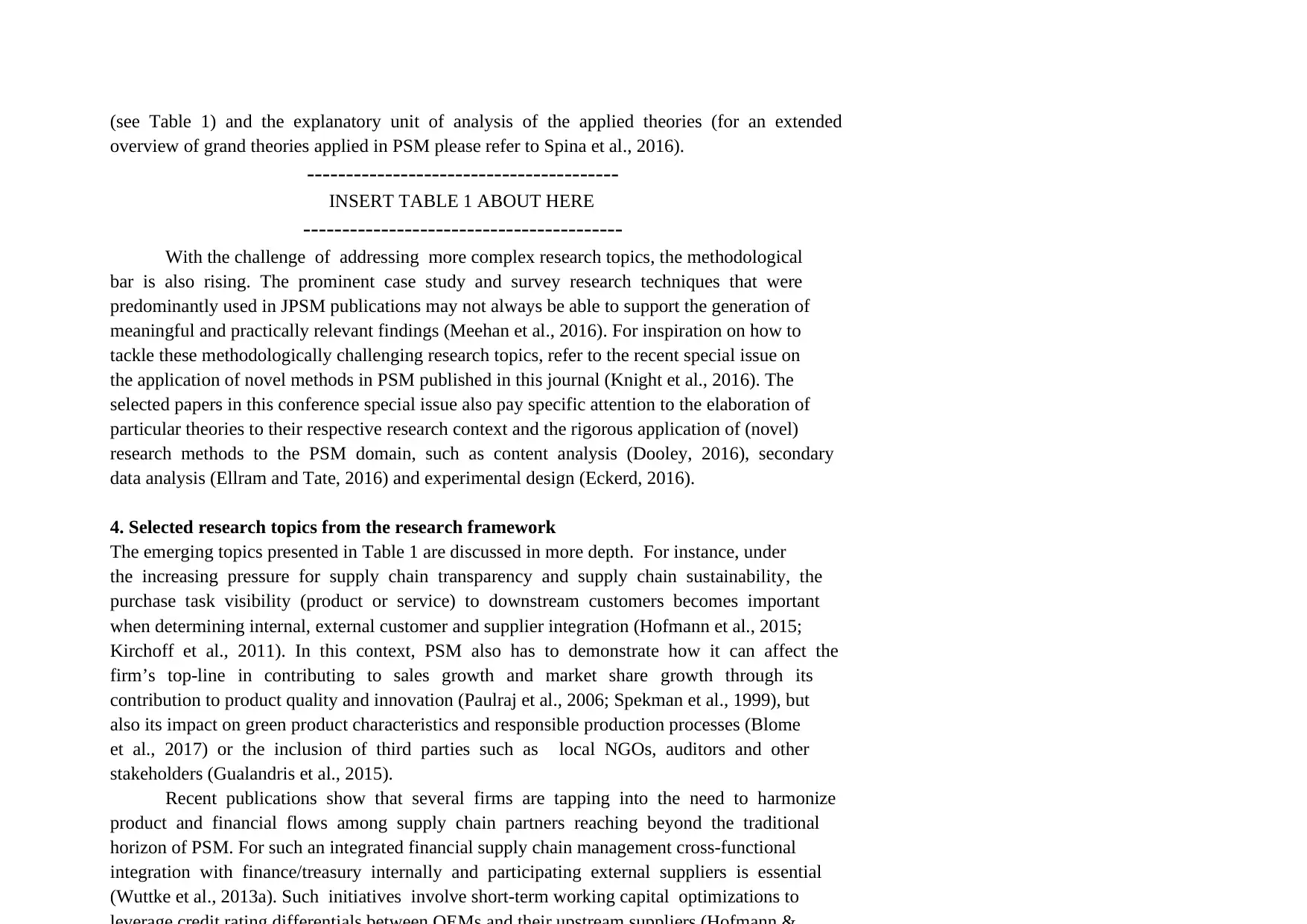
(see Table 1) and the explanatory unit of analysis of the applied theories (for an extended
overview of grand theories applied in PSM please refer to Spina et al., 2016).
----------------------------------------
INSERT TABLE 1 ABOUT HERE
-----------------------------------------
With the challenge of addressing more complex research topics, the methodological
bar is also rising. The prominent case study and survey research techniques that were
predominantly used in JPSM publications may not always be able to support the generation of
meaningful and practically relevant findings (Meehan et al., 2016). For inspiration on how to
tackle these methodologically challenging research topics, refer to the recent special issue on
the application of novel methods in PSM published in this journal (Knight et al., 2016). The
selected papers in this conference special issue also pay specific attention to the elaboration of
particular theories to their respective research context and the rigorous application of (novel)
research methods to the PSM domain, such as content analysis (Dooley, 2016), secondary
data analysis (Ellram and Tate, 2016) and experimental design (Eckerd, 2016).
4. Selected research topics from the research framework
The emerging topics presented in Table 1 are discussed in more depth. For instance, under
the increasing pressure for supply chain transparency and supply chain sustainability, the
purchase task visibility (product or service) to downstream customers becomes important
when determining internal, external customer and supplier integration (Hofmann et al., 2015;
Kirchoff et al., 2011). In this context, PSM also has to demonstrate how it can affect the
firm’s top-line in contributing to sales growth and market share growth through its
contribution to product quality and innovation (Paulraj et al., 2006; Spekman et al., 1999), but
also its impact on green product characteristics and responsible production processes (Blome
et al., 2017) or the inclusion of third parties such as local NGOs, auditors and other
stakeholders (Gualandris et al., 2015).
Recent publications show that several firms are tapping into the need to harmonize
product and financial flows among supply chain partners reaching beyond the traditional
horizon of PSM. For such an integrated financial supply chain management cross-functional
integration with finance/treasury internally and participating external suppliers is essential
(Wuttke et al., 2013a). Such initiatives involve short-term working capital optimizations to
overview of grand theories applied in PSM please refer to Spina et al., 2016).
----------------------------------------
INSERT TABLE 1 ABOUT HERE
-----------------------------------------
With the challenge of addressing more complex research topics, the methodological
bar is also rising. The prominent case study and survey research techniques that were
predominantly used in JPSM publications may not always be able to support the generation of
meaningful and practically relevant findings (Meehan et al., 2016). For inspiration on how to
tackle these methodologically challenging research topics, refer to the recent special issue on
the application of novel methods in PSM published in this journal (Knight et al., 2016). The
selected papers in this conference special issue also pay specific attention to the elaboration of
particular theories to their respective research context and the rigorous application of (novel)
research methods to the PSM domain, such as content analysis (Dooley, 2016), secondary
data analysis (Ellram and Tate, 2016) and experimental design (Eckerd, 2016).
4. Selected research topics from the research framework
The emerging topics presented in Table 1 are discussed in more depth. For instance, under
the increasing pressure for supply chain transparency and supply chain sustainability, the
purchase task visibility (product or service) to downstream customers becomes important
when determining internal, external customer and supplier integration (Hofmann et al., 2015;
Kirchoff et al., 2011). In this context, PSM also has to demonstrate how it can affect the
firm’s top-line in contributing to sales growth and market share growth through its
contribution to product quality and innovation (Paulraj et al., 2006; Spekman et al., 1999), but
also its impact on green product characteristics and responsible production processes (Blome
et al., 2017) or the inclusion of third parties such as local NGOs, auditors and other
stakeholders (Gualandris et al., 2015).
Recent publications show that several firms are tapping into the need to harmonize
product and financial flows among supply chain partners reaching beyond the traditional
horizon of PSM. For such an integrated financial supply chain management cross-functional
integration with finance/treasury internally and participating external suppliers is essential
(Wuttke et al., 2013a). Such initiatives involve short-term working capital optimizations to

property rights and agreements. With their ability to keep track of every transaction through a
decentralized mechanism of ownership, blockchains offer transparency and accountability of
information. Hence, they are likely to affect the sphere of sustainable supply chain
management (Casey & Wong, 2017). For example, materials, components and even minerals
could be traced back and verified. It could have potentially prevented recent sustainability
scandals on conflict mineral or the horse meat scandal from 2013 (Hofmann et al., 2015).
Problems in integration and close collaboration in supply networks are often of
organizations’ own making. For many purchasing managers, supplier integration comes at a
price, which is dependence on and vulnerability to suppliers. For them, PSM is still often
conceived to be a zero-sum game that results in supplier squeezing (Schleper et al., 2015). It
is the power perspectives that require more scholarly attention. Recently, some studies have
started to scrutinize these topics, such as the role of third party organizations in lowering
power differences and social distance, thereby reducing overall transaction costs (e.g. Adobor
& McMullen, 2014), the importance of power in defining the supply base structure (Ateş et
al., 2015), power dynamics in dyads (Lacoste & Johnsen, 2015) or the factor of power
imbalances for supply chain collaboration in general (Brito & Miguel, 2017) and in contexts
of sustainability (Touboulic & Walker, 2015). It is particularly crucial to extend the view
from a dyadic to a network perspective (Carnovale et al., 2017; Finne et al., 2015;
Geldermann et al., 2008).
5. Selection of papers for this special issue
After the conference, the editorial team invited the twelve best papers to submit their work to
this special issue. Following the regular JPSM reviewing procedures, four papers were
accepted .1 Each one addresses a specific topic within the PSM domain focusing particularly
on its contribution to supply chain integration and overall supply chain management
effectiveness. Furthermore, two additional papers not presented at the 2016 conference (by
Aitken & Paton, and Li & Huang) have been included in this special issue due to their topical
fit2.
The first article in this issue, by Joanne Meehan, Laura Menzies and Michaelides
Roula compares the growing topic of value-based procurement to saving-oriented aggregation
based procurement in the public healthcare sector in the UK. The article illustrated how PSM
can contribute to long-term innovation while still providing efficiency gains. Based on
hermeneutic analysis the article points out how barriers of the transition can be overcome.
decentralized mechanism of ownership, blockchains offer transparency and accountability of
information. Hence, they are likely to affect the sphere of sustainable supply chain
management (Casey & Wong, 2017). For example, materials, components and even minerals
could be traced back and verified. It could have potentially prevented recent sustainability
scandals on conflict mineral or the horse meat scandal from 2013 (Hofmann et al., 2015).
Problems in integration and close collaboration in supply networks are often of
organizations’ own making. For many purchasing managers, supplier integration comes at a
price, which is dependence on and vulnerability to suppliers. For them, PSM is still often
conceived to be a zero-sum game that results in supplier squeezing (Schleper et al., 2015). It
is the power perspectives that require more scholarly attention. Recently, some studies have
started to scrutinize these topics, such as the role of third party organizations in lowering
power differences and social distance, thereby reducing overall transaction costs (e.g. Adobor
& McMullen, 2014), the importance of power in defining the supply base structure (Ateş et
al., 2015), power dynamics in dyads (Lacoste & Johnsen, 2015) or the factor of power
imbalances for supply chain collaboration in general (Brito & Miguel, 2017) and in contexts
of sustainability (Touboulic & Walker, 2015). It is particularly crucial to extend the view
from a dyadic to a network perspective (Carnovale et al., 2017; Finne et al., 2015;
Geldermann et al., 2008).
5. Selection of papers for this special issue
After the conference, the editorial team invited the twelve best papers to submit their work to
this special issue. Following the regular JPSM reviewing procedures, four papers were
accepted .1 Each one addresses a specific topic within the PSM domain focusing particularly
on its contribution to supply chain integration and overall supply chain management
effectiveness. Furthermore, two additional papers not presented at the 2016 conference (by
Aitken & Paton, and Li & Huang) have been included in this special issue due to their topical
fit2.
The first article in this issue, by Joanne Meehan, Laura Menzies and Michaelides
Roula compares the growing topic of value-based procurement to saving-oriented aggregation
based procurement in the public healthcare sector in the UK. The article illustrated how PSM
can contribute to long-term innovation while still providing efficiency gains. Based on
hermeneutic analysis the article points out how barriers of the transition can be overcome.
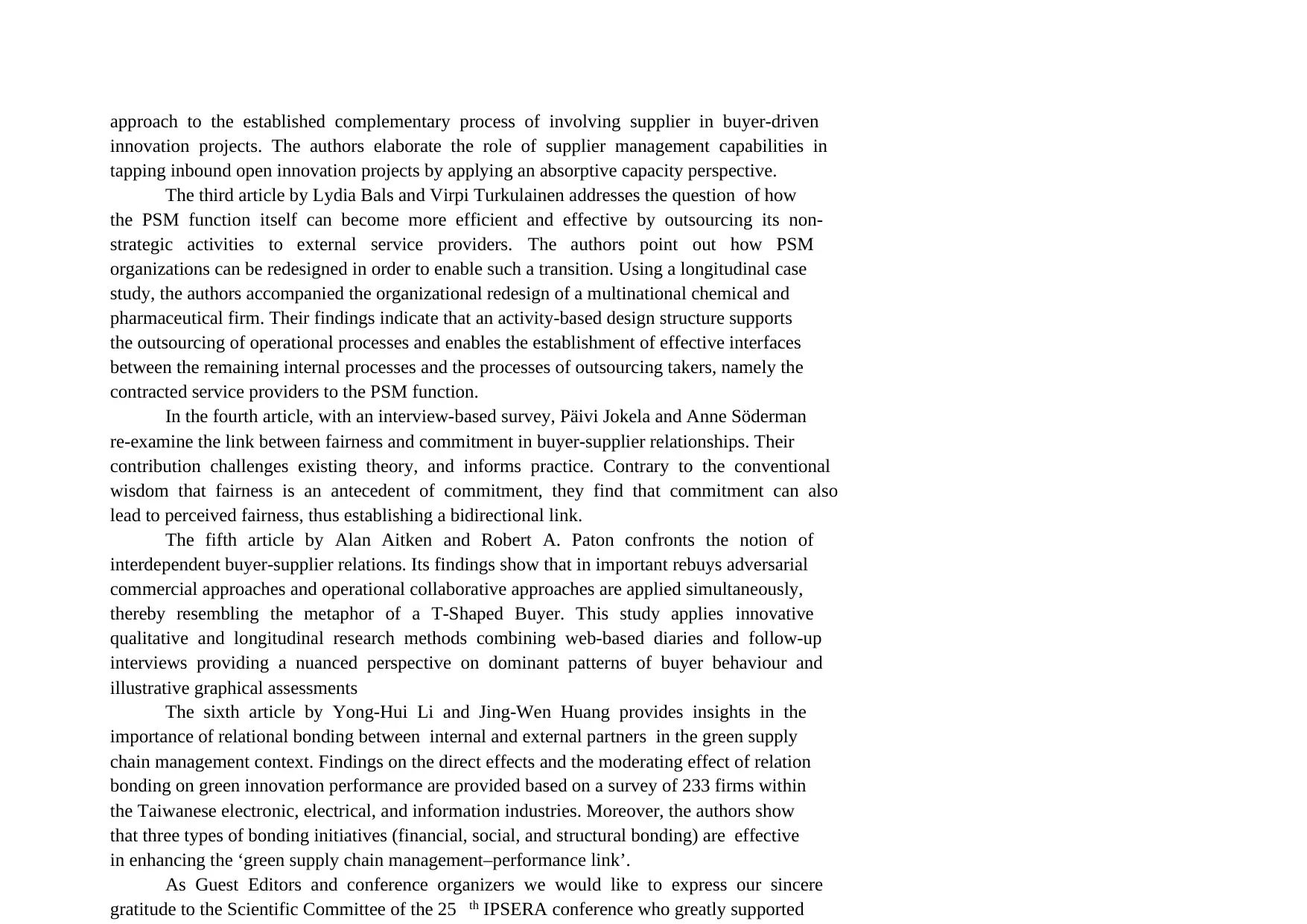
approach to the established complementary process of involving supplier in buyer-driven
innovation projects. The authors elaborate the role of supplier management capabilities in
tapping inbound open innovation projects by applying an absorptive capacity perspective.
The third article by Lydia Bals and Virpi Turkulainen addresses the question of how
the PSM function itself can become more efficient and effective by outsourcing its non-
strategic activities to external service providers. The authors point out how PSM
organizations can be redesigned in order to enable such a transition. Using a longitudinal case
study, the authors accompanied the organizational redesign of a multinational chemical and
pharmaceutical firm. Their findings indicate that an activity-based design structure supports
the outsourcing of operational processes and enables the establishment of effective interfaces
between the remaining internal processes and the processes of outsourcing takers, namely the
contracted service providers to the PSM function.
In the fourth article, with an interview-based survey, Päivi Jokela and Anne Söderman
re-examine the link between fairness and commitment in buyer-supplier relationships. Their
contribution challenges existing theory, and informs practice. Contrary to the conventional
wisdom that fairness is an antecedent of commitment, they find that commitment can also
lead to perceived fairness, thus establishing a bidirectional link.
The fifth article by Alan Aitken and Robert A. Paton confronts the notion of
interdependent buyer-supplier relations. Its findings show that in important rebuys adversarial
commercial approaches and operational collaborative approaches are applied simultaneously,
thereby resembling the metaphor of a T-Shaped Buyer. This study applies innovative
qualitative and longitudinal research methods combining web-based diaries and follow-up
interviews providing a nuanced perspective on dominant patterns of buyer behaviour and
illustrative graphical assessments
The sixth article by Yong-Hui Li and Jing-Wen Huang provides insights in the
importance of relational bonding between internal and external partners in the green supply
chain management context. Findings on the direct effects and the moderating effect of relation
bonding on green innovation performance are provided based on a survey of 233 firms within
the Taiwanese electronic, electrical, and information industries. Moreover, the authors show
that three types of bonding initiatives (financial, social, and structural bonding) are effective
in enhancing the ‘green supply chain management–performance link’.
As Guest Editors and conference organizers we would like to express our sincere
gratitude to the Scientific Committee of the 25 th IPSERA conference who greatly supported
innovation projects. The authors elaborate the role of supplier management capabilities in
tapping inbound open innovation projects by applying an absorptive capacity perspective.
The third article by Lydia Bals and Virpi Turkulainen addresses the question of how
the PSM function itself can become more efficient and effective by outsourcing its non-
strategic activities to external service providers. The authors point out how PSM
organizations can be redesigned in order to enable such a transition. Using a longitudinal case
study, the authors accompanied the organizational redesign of a multinational chemical and
pharmaceutical firm. Their findings indicate that an activity-based design structure supports
the outsourcing of operational processes and enables the establishment of effective interfaces
between the remaining internal processes and the processes of outsourcing takers, namely the
contracted service providers to the PSM function.
In the fourth article, with an interview-based survey, Päivi Jokela and Anne Söderman
re-examine the link between fairness and commitment in buyer-supplier relationships. Their
contribution challenges existing theory, and informs practice. Contrary to the conventional
wisdom that fairness is an antecedent of commitment, they find that commitment can also
lead to perceived fairness, thus establishing a bidirectional link.
The fifth article by Alan Aitken and Robert A. Paton confronts the notion of
interdependent buyer-supplier relations. Its findings show that in important rebuys adversarial
commercial approaches and operational collaborative approaches are applied simultaneously,
thereby resembling the metaphor of a T-Shaped Buyer. This study applies innovative
qualitative and longitudinal research methods combining web-based diaries and follow-up
interviews providing a nuanced perspective on dominant patterns of buyer behaviour and
illustrative graphical assessments
The sixth article by Yong-Hui Li and Jing-Wen Huang provides insights in the
importance of relational bonding between internal and external partners in the green supply
chain management context. Findings on the direct effects and the moderating effect of relation
bonding on green innovation performance are provided based on a survey of 233 firms within
the Taiwanese electronic, electrical, and information industries. Moreover, the authors show
that three types of bonding initiatives (financial, social, and structural bonding) are effective
in enhancing the ‘green supply chain management–performance link’.
As Guest Editors and conference organizers we would like to express our sincere
gratitude to the Scientific Committee of the 25 th IPSERA conference who greatly supported
Secure Best Marks with AI Grader
Need help grading? Try our AI Grader for instant feedback on your assignments.
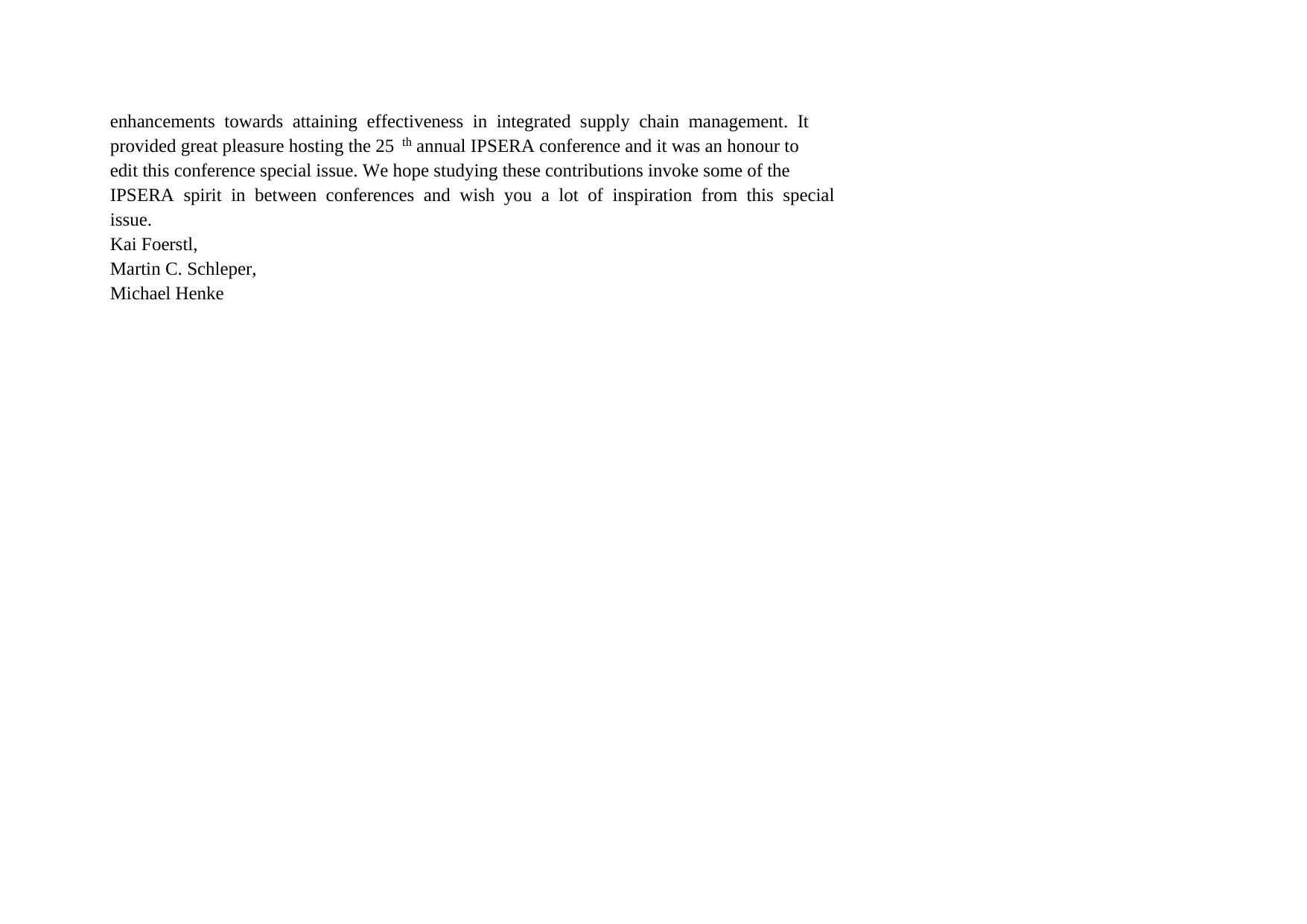
enhancements towards attaining effectiveness in integrated supply chain management. It
provided great pleasure hosting the 25 th annual IPSERA conference and it was an honour to
edit this conference special issue. We hope studying these contributions invoke some of the
IPSERA spirit in between conferences and wish you a lot of inspiration from this special
issue.
Kai Foerstl,
Martin C. Schleper,
Michael Henke
provided great pleasure hosting the 25 th annual IPSERA conference and it was an honour to
edit this conference special issue. We hope studying these contributions invoke some of the
IPSERA spirit in between conferences and wish you a lot of inspiration from this special
issue.
Kai Foerstl,
Martin C. Schleper,
Michael Henke
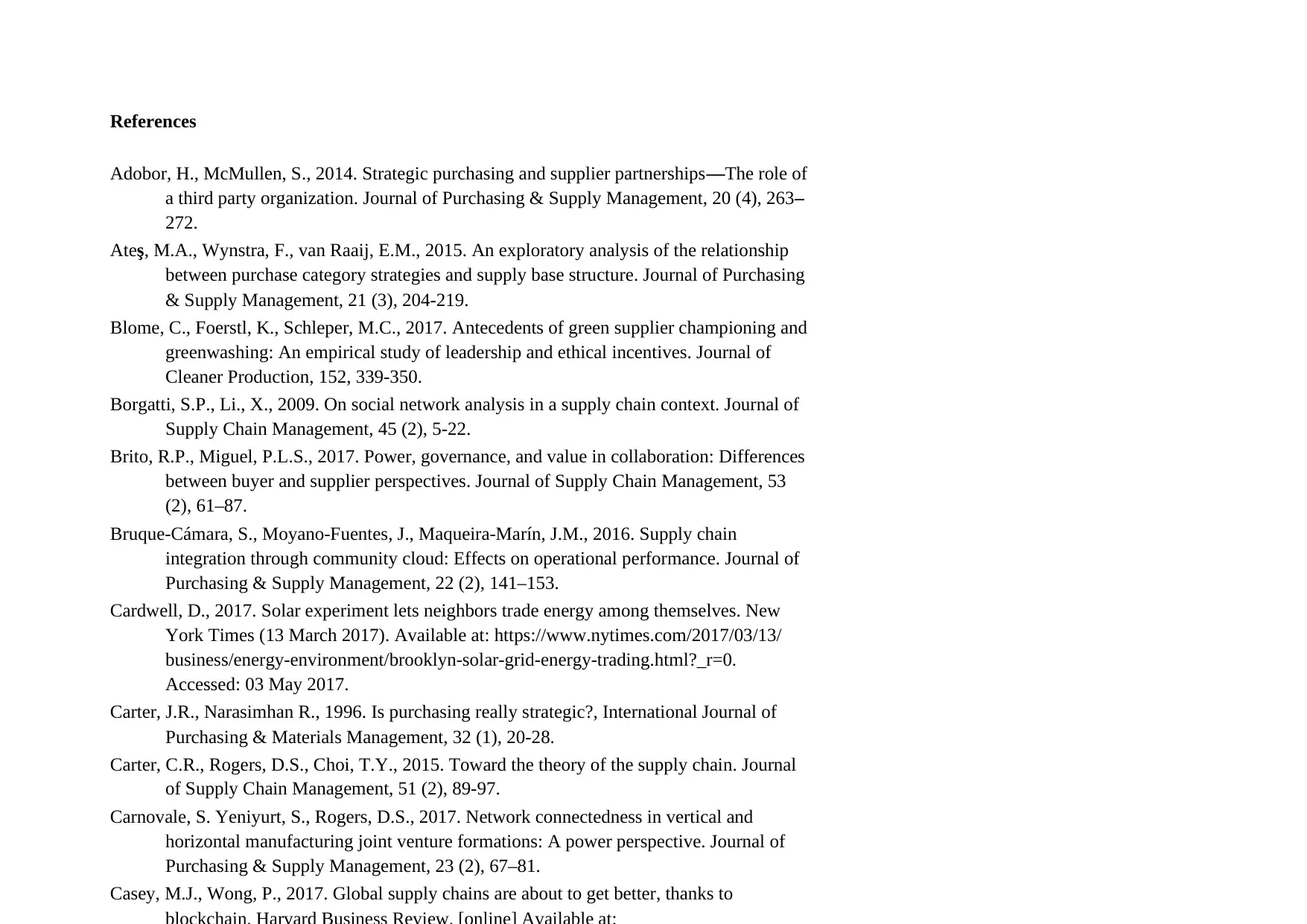
References
Adobor, H., McMullen, S., 2014. Strategic purchasing and supplier partnerships—The role of
a third party organization. Journal of Purchasing & Supply Management, 20 (4), 263–
272.
Ateş , M.A., Wynstra, F., van Raaij, E.M., 2015. An exploratory analysis of the relationship
between purchase category strategies and supply base structure. Journal of Purchasing
& Supply Management, 21 (3), 204-219.
Blome, C., Foerstl, K., Schleper, M.C., 2017. Antecedents of green supplier championing and
greenwashing: An empirical study of leadership and ethical incentives. Journal of
Cleaner Production, 152, 339-350.
Borgatti, S.P., Li., X., 2009. On social network analysis in a supply chain context. Journal of
Supply Chain Management, 45 (2), 5-22.
Brito, R.P., Miguel, P.L.S., 2017. Power, governance, and value in collaboration: Differences
between buyer and supplier perspectives. Journal of Supply Chain Management, 53
(2), 61–87.
Bruque-Cámara, S., Moyano-Fuentes, J., Maqueira-Marín, J.M., 2016. Supply chain
integration through community cloud: Effects on operational performance. Journal of
Purchasing & Supply Management, 22 (2), 141–153.
Cardwell, D., 2017. Solar experiment lets neighbors trade energy among themselves. New
York Times (13 March 2017). Available at: https://www.nytimes.com/2017/03/13/
business/energy-environment/brooklyn-solar-grid-energy-trading.html?_r=0.
Accessed: 03 May 2017.
Carter, J.R., Narasimhan R., 1996. Is purchasing really strategic?, International Journal of
Purchasing & Materials Management, 32 (1), 20-28.
Carter, C.R., Rogers, D.S., Choi, T.Y., 2015. Toward the theory of the supply chain. Journal
of Supply Chain Management, 51 (2), 89-97.
Carnovale, S. Yeniyurt, S., Rogers, D.S., 2017. Network connectedness in vertical and
horizontal manufacturing joint venture formations: A power perspective. Journal of
Purchasing & Supply Management, 23 (2), 67–81.
Casey, M.J., Wong, P., 2017. Global supply chains are about to get better, thanks to
Adobor, H., McMullen, S., 2014. Strategic purchasing and supplier partnerships—The role of
a third party organization. Journal of Purchasing & Supply Management, 20 (4), 263–
272.
Ateş , M.A., Wynstra, F., van Raaij, E.M., 2015. An exploratory analysis of the relationship
between purchase category strategies and supply base structure. Journal of Purchasing
& Supply Management, 21 (3), 204-219.
Blome, C., Foerstl, K., Schleper, M.C., 2017. Antecedents of green supplier championing and
greenwashing: An empirical study of leadership and ethical incentives. Journal of
Cleaner Production, 152, 339-350.
Borgatti, S.P., Li., X., 2009. On social network analysis in a supply chain context. Journal of
Supply Chain Management, 45 (2), 5-22.
Brito, R.P., Miguel, P.L.S., 2017. Power, governance, and value in collaboration: Differences
between buyer and supplier perspectives. Journal of Supply Chain Management, 53
(2), 61–87.
Bruque-Cámara, S., Moyano-Fuentes, J., Maqueira-Marín, J.M., 2016. Supply chain
integration through community cloud: Effects on operational performance. Journal of
Purchasing & Supply Management, 22 (2), 141–153.
Cardwell, D., 2017. Solar experiment lets neighbors trade energy among themselves. New
York Times (13 March 2017). Available at: https://www.nytimes.com/2017/03/13/
business/energy-environment/brooklyn-solar-grid-energy-trading.html?_r=0.
Accessed: 03 May 2017.
Carter, J.R., Narasimhan R., 1996. Is purchasing really strategic?, International Journal of
Purchasing & Materials Management, 32 (1), 20-28.
Carter, C.R., Rogers, D.S., Choi, T.Y., 2015. Toward the theory of the supply chain. Journal
of Supply Chain Management, 51 (2), 89-97.
Carnovale, S. Yeniyurt, S., Rogers, D.S., 2017. Network connectedness in vertical and
horizontal manufacturing joint venture formations: A power perspective. Journal of
Purchasing & Supply Management, 23 (2), 67–81.
Casey, M.J., Wong, P., 2017. Global supply chains are about to get better, thanks to
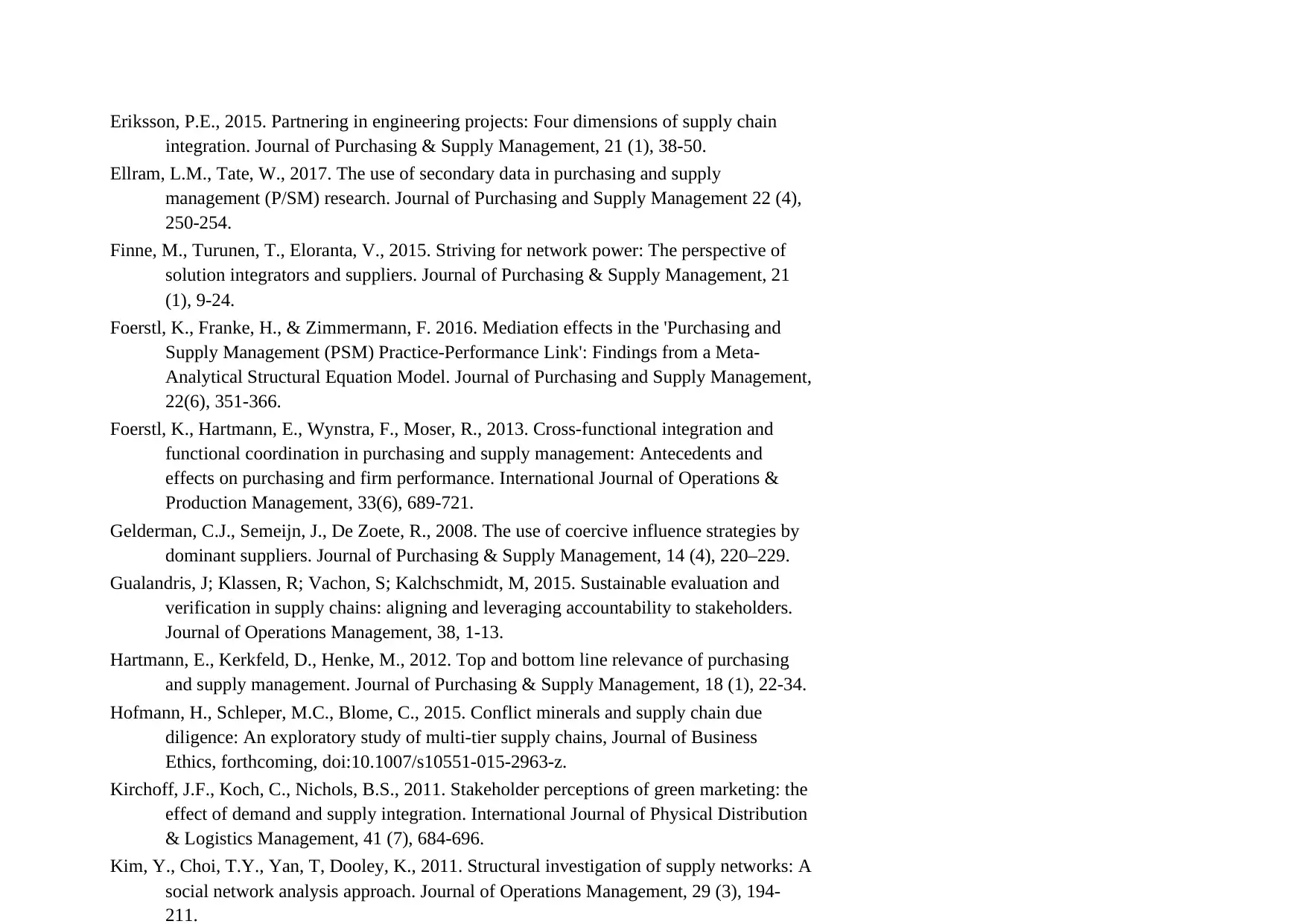
Eriksson, P.E., 2015. Partnering in engineering projects: Four dimensions of supply chain
integration. Journal of Purchasing & Supply Management, 21 (1), 38-50.
Ellram, L.M., Tate, W., 2017. The use of secondary data in purchasing and supply
management (P/SM) research. Journal of Purchasing and Supply Management 22 (4),
250-254.
Finne, M., Turunen, T., Eloranta, V., 2015. Striving for network power: The perspective of
solution integrators and suppliers. Journal of Purchasing & Supply Management, 21
(1), 9-24.
Foerstl, K., Franke, H., & Zimmermann, F. 2016. Mediation effects in the 'Purchasing and
Supply Management (PSM) Practice-Performance Link': Findings from a Meta-
Analytical Structural Equation Model. Journal of Purchasing and Supply Management,
22(6), 351-366.
Foerstl, K., Hartmann, E., Wynstra, F., Moser, R., 2013. Cross-functional integration and
functional coordination in purchasing and supply management: Antecedents and
effects on purchasing and firm performance. International Journal of Operations &
Production Management, 33(6), 689-721.
Gelderman, C.J., Semeijn, J., De Zoete, R., 2008. The use of coercive influence strategies by
dominant suppliers. Journal of Purchasing & Supply Management, 14 (4), 220–229.
Gualandris, J; Klassen, R; Vachon, S; Kalchschmidt, M, 2015. Sustainable evaluation and
verification in supply chains: aligning and leveraging accountability to stakeholders.
Journal of Operations Management, 38, 1-13.
Hartmann, E., Kerkfeld, D., Henke, M., 2012. Top and bottom line relevance of purchasing
and supply management. Journal of Purchasing & Supply Management, 18 (1), 22-34.
Hofmann, H., Schleper, M.C., Blome, C., 2015. Conflict minerals and supply chain due
diligence: An exploratory study of multi-tier supply chains, Journal of Business
Ethics, forthcoming, doi:10.1007/s10551-015-2963-z.
Kirchoff, J.F., Koch, C., Nichols, B.S., 2011. Stakeholder perceptions of green marketing: the
effect of demand and supply integration. International Journal of Physical Distribution
& Logistics Management, 41 (7), 684-696.
Kim, Y., Choi, T.Y., Yan, T, Dooley, K., 2011. Structural investigation of supply networks: A
social network analysis approach. Journal of Operations Management, 29 (3), 194-
211.
integration. Journal of Purchasing & Supply Management, 21 (1), 38-50.
Ellram, L.M., Tate, W., 2017. The use of secondary data in purchasing and supply
management (P/SM) research. Journal of Purchasing and Supply Management 22 (4),
250-254.
Finne, M., Turunen, T., Eloranta, V., 2015. Striving for network power: The perspective of
solution integrators and suppliers. Journal of Purchasing & Supply Management, 21
(1), 9-24.
Foerstl, K., Franke, H., & Zimmermann, F. 2016. Mediation effects in the 'Purchasing and
Supply Management (PSM) Practice-Performance Link': Findings from a Meta-
Analytical Structural Equation Model. Journal of Purchasing and Supply Management,
22(6), 351-366.
Foerstl, K., Hartmann, E., Wynstra, F., Moser, R., 2013. Cross-functional integration and
functional coordination in purchasing and supply management: Antecedents and
effects on purchasing and firm performance. International Journal of Operations &
Production Management, 33(6), 689-721.
Gelderman, C.J., Semeijn, J., De Zoete, R., 2008. The use of coercive influence strategies by
dominant suppliers. Journal of Purchasing & Supply Management, 14 (4), 220–229.
Gualandris, J; Klassen, R; Vachon, S; Kalchschmidt, M, 2015. Sustainable evaluation and
verification in supply chains: aligning and leveraging accountability to stakeholders.
Journal of Operations Management, 38, 1-13.
Hartmann, E., Kerkfeld, D., Henke, M., 2012. Top and bottom line relevance of purchasing
and supply management. Journal of Purchasing & Supply Management, 18 (1), 22-34.
Hofmann, H., Schleper, M.C., Blome, C., 2015. Conflict minerals and supply chain due
diligence: An exploratory study of multi-tier supply chains, Journal of Business
Ethics, forthcoming, doi:10.1007/s10551-015-2963-z.
Kirchoff, J.F., Koch, C., Nichols, B.S., 2011. Stakeholder perceptions of green marketing: the
effect of demand and supply integration. International Journal of Physical Distribution
& Logistics Management, 41 (7), 684-696.
Kim, Y., Choi, T.Y., Yan, T, Dooley, K., 2011. Structural investigation of supply networks: A
social network analysis approach. Journal of Operations Management, 29 (3), 194-
211.
Paraphrase This Document
Need a fresh take? Get an instant paraphrase of this document with our AI Paraphraser
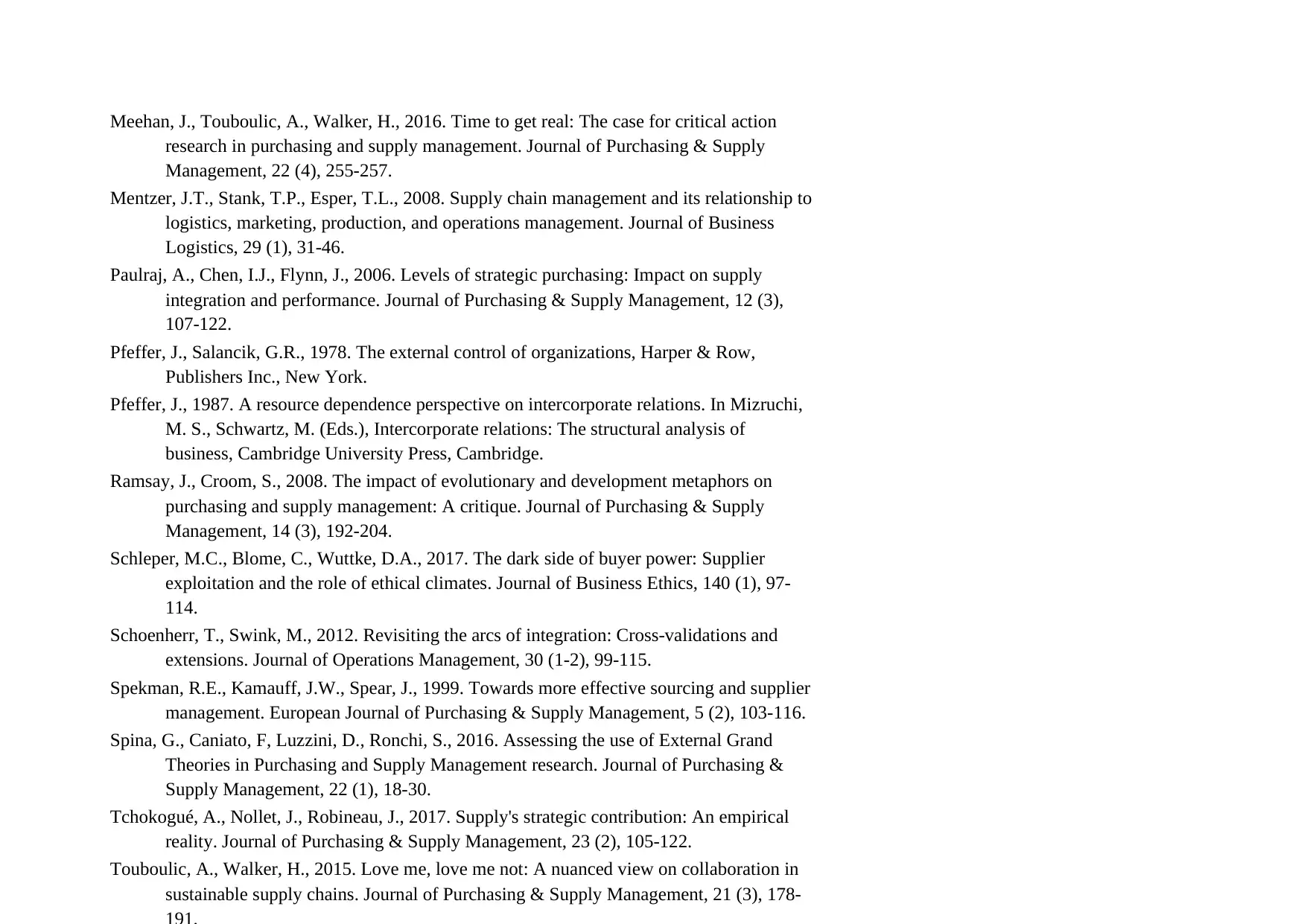
Meehan, J., Touboulic, A., Walker, H., 2016. Time to get real: The case for critical action
research in purchasing and supply management. Journal of Purchasing & Supply
Management, 22 (4), 255-257.
Mentzer, J.T., Stank, T.P., Esper, T.L., 2008. Supply chain management and its relationship to
logistics, marketing, production, and operations management. Journal of Business
Logistics, 29 (1), 31-46.
Paulraj, A., Chen, I.J., Flynn, J., 2006. Levels of strategic purchasing: Impact on supply
integration and performance. Journal of Purchasing & Supply Management, 12 (3),
107-122.
Pfeffer, J., Salancik, G.R., 1978. The external control of organizations, Harper & Row,
Publishers Inc., New York.
Pfeffer, J., 1987. A resource dependence perspective on intercorporate relations. In Mizruchi,
M. S., Schwartz, M. (Eds.), Intercorporate relations: The structural analysis of
business, Cambridge University Press, Cambridge.
Ramsay, J., Croom, S., 2008. The impact of evolutionary and development metaphors on
purchasing and supply management: A critique. Journal of Purchasing & Supply
Management, 14 (3), 192-204.
Schleper, M.C., Blome, C., Wuttke, D.A., 2017. The dark side of buyer power: Supplier
exploitation and the role of ethical climates. Journal of Business Ethics, 140 (1), 97-
114.
Schoenherr, T., Swink, M., 2012. Revisiting the arcs of integration: Cross-validations and
extensions. Journal of Operations Management, 30 (1-2), 99-115.
Spekman, R.E., Kamauff, J.W., Spear, J., 1999. Towards more effective sourcing and supplier
management. European Journal of Purchasing & Supply Management, 5 (2), 103-116.
Spina, G., Caniato, F, Luzzini, D., Ronchi, S., 2016. Assessing the use of External Grand
Theories in Purchasing and Supply Management research. Journal of Purchasing &
Supply Management, 22 (1), 18-30.
Tchokogué , A., Nollet, J., Robineau, J., 2017. Supply's strategic contribution: An empirical
reality. Journal of Purchasing & Supply Management, 23 (2), 105-122.
Touboulic, A., Walker, H., 2015. Love me, love me not: A nuanced view on collaboration in
sustainable supply chains. Journal of Purchasing & Supply Management, 21 (3), 178-
research in purchasing and supply management. Journal of Purchasing & Supply
Management, 22 (4), 255-257.
Mentzer, J.T., Stank, T.P., Esper, T.L., 2008. Supply chain management and its relationship to
logistics, marketing, production, and operations management. Journal of Business
Logistics, 29 (1), 31-46.
Paulraj, A., Chen, I.J., Flynn, J., 2006. Levels of strategic purchasing: Impact on supply
integration and performance. Journal of Purchasing & Supply Management, 12 (3),
107-122.
Pfeffer, J., Salancik, G.R., 1978. The external control of organizations, Harper & Row,
Publishers Inc., New York.
Pfeffer, J., 1987. A resource dependence perspective on intercorporate relations. In Mizruchi,
M. S., Schwartz, M. (Eds.), Intercorporate relations: The structural analysis of
business, Cambridge University Press, Cambridge.
Ramsay, J., Croom, S., 2008. The impact of evolutionary and development metaphors on
purchasing and supply management: A critique. Journal of Purchasing & Supply
Management, 14 (3), 192-204.
Schleper, M.C., Blome, C., Wuttke, D.A., 2017. The dark side of buyer power: Supplier
exploitation and the role of ethical climates. Journal of Business Ethics, 140 (1), 97-
114.
Schoenherr, T., Swink, M., 2012. Revisiting the arcs of integration: Cross-validations and
extensions. Journal of Operations Management, 30 (1-2), 99-115.
Spekman, R.E., Kamauff, J.W., Spear, J., 1999. Towards more effective sourcing and supplier
management. European Journal of Purchasing & Supply Management, 5 (2), 103-116.
Spina, G., Caniato, F, Luzzini, D., Ronchi, S., 2016. Assessing the use of External Grand
Theories in Purchasing and Supply Management research. Journal of Purchasing &
Supply Management, 22 (1), 18-30.
Tchokogué , A., Nollet, J., Robineau, J., 2017. Supply's strategic contribution: An empirical
reality. Journal of Purchasing & Supply Management, 23 (2), 105-122.
Touboulic, A., Walker, H., 2015. Love me, love me not: A nuanced view on collaboration in
sustainable supply chains. Journal of Purchasing & Supply Management, 21 (3), 178-
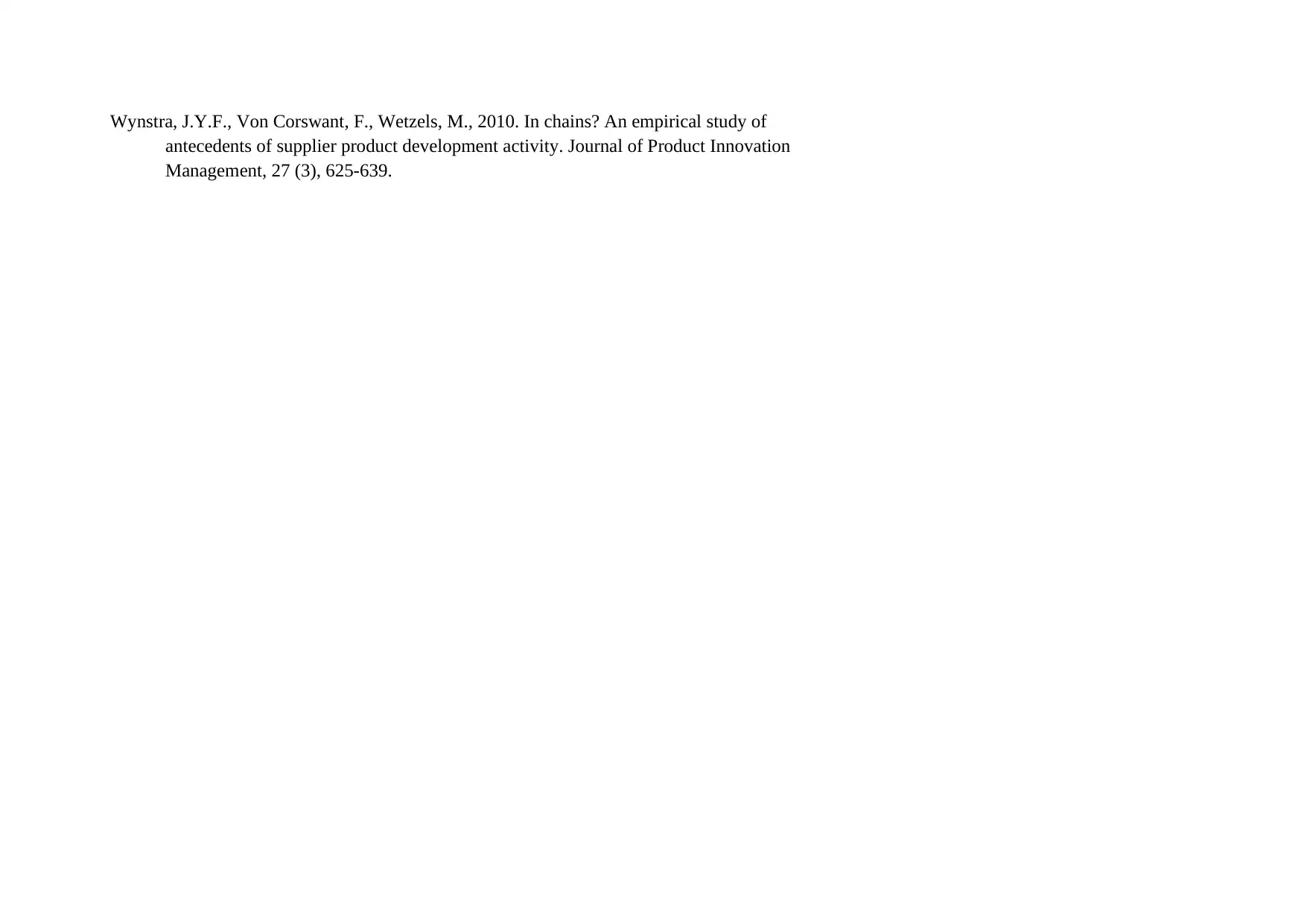
Wynstra, J.Y.F., Von Corswant, F., Wetzels, M., 2010. In chains? An empirical study of
antecedents of supplier product development activity. Journal of Product Innovation
Management, 27 (3), 625-639.
antecedents of supplier product development activity. Journal of Product Innovation
Management, 27 (3), 625-639.

13
Table 1 – A research framework for PSM’s impact on supply chain effectiveness, with illustrative research questions
Level of
Impact
Processes (flow types) Products
Performance (operational,
market, financial) Society
Observational
Unit of
Analysis
Individual
-What is the link between
process standardization on
internal and external
collaboration of PSM
professionals?
-What are the effects of (mis-)
matching personality traits between
PSM and sales agents on operational
and strategic integration?
-What is the link between
personality traits, individual
networking and job performance
in PSM and other functions
involved in SCM?
-How can CSR engagement
attract and retain talents from
other functions and from outside
the firm to PSM and SCM
departments?
Sourcing Team
(cross-functional
and/or cross-
firm)
-How can team composition
positively/negatively affect
information flow in sourcing
teams?
-How does diversity in sourcing
teams foster product innovation and
integration with suppliers and
customers?
-What is the effect of cross-
functional goal (mis-)alignment,
team composition and team
conflict on sourcing project
performance?
-How can dyadic or triadic cross-
firm teams support ecological and
social development in emerging
markets?
Departmental/
Functional
-Does the use of social media
and other opportunities for big
data analytics increase the
information flow across
functions for supply chain risk
management?
-How can desorptive and absorptive
capacity in PSM drive the acceptance
of incremental and radical product
innovations by PSMs internal
stakeholders?
-What is the effect of finance–
PSM integration on the adoption
of supply chain finance
techniques and buying firm
performance?
-How can PSM philanthropy
projects impact societal
development in emerging markets
the firm sources from?
Buying or
Supplying Firm
-Which PSM processes are
suitable for outsourcing to
external service providers?
-How can supplier product and
process innovations be effectively
applied in the buyers’ products and
processes?
-What are the downsides of
internal integration and alignment
on performance over time?
-What is the role, SME suppliers
can play for sustainable
development despite their limited
resources?
Table 1 – A research framework for PSM’s impact on supply chain effectiveness, with illustrative research questions
Level of
Impact
Processes (flow types) Products
Performance (operational,
market, financial) Society
Observational
Unit of
Analysis
Individual
-What is the link between
process standardization on
internal and external
collaboration of PSM
professionals?
-What are the effects of (mis-)
matching personality traits between
PSM and sales agents on operational
and strategic integration?
-What is the link between
personality traits, individual
networking and job performance
in PSM and other functions
involved in SCM?
-How can CSR engagement
attract and retain talents from
other functions and from outside
the firm to PSM and SCM
departments?
Sourcing Team
(cross-functional
and/or cross-
firm)
-How can team composition
positively/negatively affect
information flow in sourcing
teams?
-How does diversity in sourcing
teams foster product innovation and
integration with suppliers and
customers?
-What is the effect of cross-
functional goal (mis-)alignment,
team composition and team
conflict on sourcing project
performance?
-How can dyadic or triadic cross-
firm teams support ecological and
social development in emerging
markets?
Departmental/
Functional
-Does the use of social media
and other opportunities for big
data analytics increase the
information flow across
functions for supply chain risk
management?
-How can desorptive and absorptive
capacity in PSM drive the acceptance
of incremental and radical product
innovations by PSMs internal
stakeholders?
-What is the effect of finance–
PSM integration on the adoption
of supply chain finance
techniques and buying firm
performance?
-How can PSM philanthropy
projects impact societal
development in emerging markets
the firm sources from?
Buying or
Supplying Firm
-Which PSM processes are
suitable for outsourcing to
external service providers?
-How can supplier product and
process innovations be effectively
applied in the buyers’ products and
processes?
-What are the downsides of
internal integration and alignment
on performance over time?
-What is the role, SME suppliers
can play for sustainable
development despite their limited
resources?
Secure Best Marks with AI Grader
Need help grading? Try our AI Grader for instant feedback on your assignments.
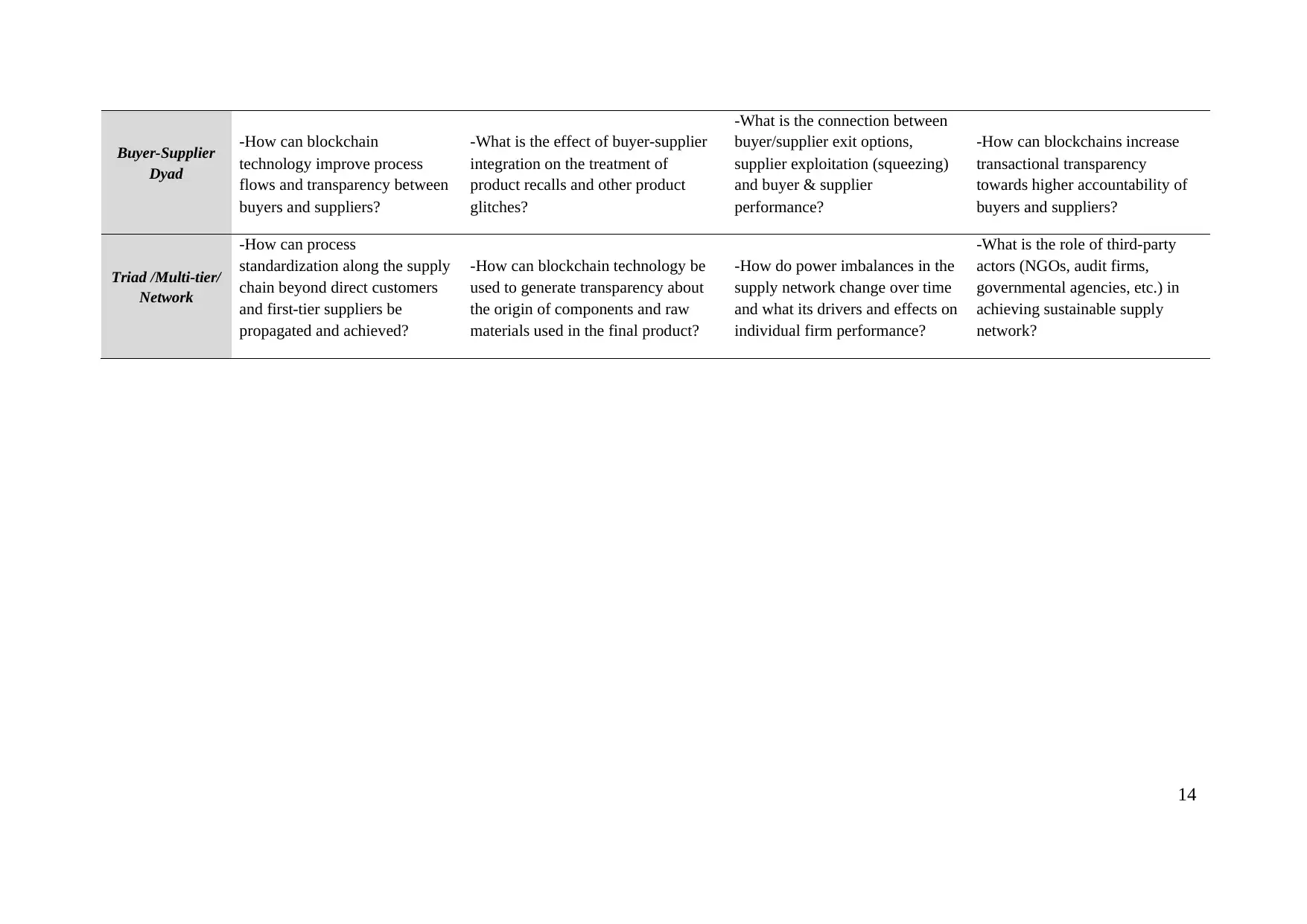
14
Buyer-Supplier
Dyad
-How can blockchain
technology improve process
flows and transparency between
buyers and suppliers?
-What is the effect of buyer-supplier
integration on the treatment of
product recalls and other product
glitches?
-What is the connection between
buyer/supplier exit options,
supplier exploitation (squeezing)
and buyer & supplier
performance?
-How can blockchains increase
transactional transparency
towards higher accountability of
buyers and suppliers?
Triad /Multi-tier/
Network
-How can process
standardization along the supply
chain beyond direct customers
and first-tier suppliers be
propagated and achieved?
-How can blockchain technology be
used to generate transparency about
the origin of components and raw
materials used in the final product?
-How do power imbalances in the
supply network change over time
and what its drivers and effects on
individual firm performance?
-What is the role of third-party
actors (NGOs, audit firms,
governmental agencies, etc.) in
achieving sustainable supply
network?
Buyer-Supplier
Dyad
-How can blockchain
technology improve process
flows and transparency between
buyers and suppliers?
-What is the effect of buyer-supplier
integration on the treatment of
product recalls and other product
glitches?
-What is the connection between
buyer/supplier exit options,
supplier exploitation (squeezing)
and buyer & supplier
performance?
-How can blockchains increase
transactional transparency
towards higher accountability of
buyers and suppliers?
Triad /Multi-tier/
Network
-How can process
standardization along the supply
chain beyond direct customers
and first-tier suppliers be
propagated and achieved?
-How can blockchain technology be
used to generate transparency about
the origin of components and raw
materials used in the final product?
-How do power imbalances in the
supply network change over time
and what its drivers and effects on
individual firm performance?
-What is the role of third-party
actors (NGOs, audit firms,
governmental agencies, etc.) in
achieving sustainable supply
network?
1 out of 14
Related Documents
Your All-in-One AI-Powered Toolkit for Academic Success.
+13062052269
info@desklib.com
Available 24*7 on WhatsApp / Email
![[object Object]](/_next/static/media/star-bottom.7253800d.svg)
Unlock your academic potential
© 2024 | Zucol Services PVT LTD | All rights reserved.